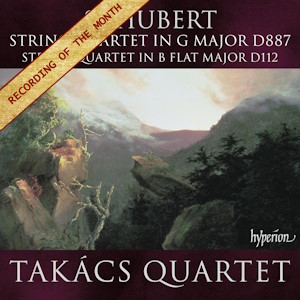
Franz Schubert (1797-1828)
String Quartet No. 15 in G major, D887 (1826)
String Quartet No. 8 in B-flat major, D112 (1814)
Takács Quartet
rec. 2023, Concert Hall, Wyastone Estate, Monmouth, UK
Hyperion CDA68423 [78]
This is the Takács Quartet’s second recording of Schubert’s late, great string quartet. The one on Decca has long been my favourite rendition of this music. That disc also contained the beautiful Notturno D897 for piano trio; the coupling here is the Quartet No. 8. The ensemble’s personnel has changed substantially. The current violist Richard O’Neill and the second violinist Harumi Rhodes now play alongside first violinist Edward Dusinberre and cellist András Fejér, the sole remaining original member.
Schubert’s last and longest string quartet may arguably be his greatest in the genre. It has been eclipsed in popularity by No.14 “Death and the Maiden”, and to a lesser extent by No.13 “Rosamunde”. In many ways, the Fifteenth Quartet presents the biggest challenge to the musicians in its almost symphonic nature and the juxtaposition of major and minor keys. It is nominally in G major, but G minor takes precedence at times.
The Takács begin powerfully: dramatic chords followed by quieter and really spooky tremolos. The dynamic range is huge compared with their earlier account, and especially with the venerable Quartetto Italiano (Philips 446 163-2). The latter, slower and heavier in every movement, do not emphasize the contrasts as much. Their upfront tremolos do not convey the mystery of the Takács, particularly in this new performance. I have never warmed to the Italians’ more dense, deliberate reading. It makes the work seems longer, less interesting, and the timing of 55 minutes is telling: the Takács take 50 minutes here and 48 in their earlier account. (I do not sense any appreciable difference between their two performances.)
The slow movement, at a nice flowing tempo, observes the Andante un poco moto marking, in an account a bit less expansive than the earlier one. The sound of the instruments here is gorgeous, with a fine tonal blend yet with plenty of clarity. The unison outburst after 3:00 is fierce, even terrifying. The conclusion of the movement well expresses a feeling of sorrow, alleviated by the final major chord.
The third movement Scherzo is light as a feather, transparent and crisp, anticipating Mendelssohn. The following trio relaxes nicely to create an ideal contrast. Indeed, the definition of the quartet’s playing is amazing, quite different from the more blended sound of the Takács’s first recording – to say nothing of Quartetto Italiano’s smoother, heavier reading that lacks the energy of either of these.
The tarantella form of the finale is again clear and incisive in this new account. There is much variety in the movement, proceeding from major to minor and back again, and from the catchy lighter theme to the forceful ending itself. The Takács’s intonation throughout is spot-on, whereas in their earlier version there were several questionable patches. I was disappointed by their Dvořák disc (review), and feared they were not the illustrious ensemble that so impressed me before. I need not have worried. In every way, this is a glorious account of Schubert’s late string quartet masterpiece.
The earlier Quartet No. 8 makes an apposite coupling. It is not without its influences of Haydn and Beethoven, but the style already looks forward to later Schubert. The work starts off with a happy and memorable theme on high violin before turning more propulsive in the key of G minor. As the Fifteenth Quartet, it alternates lyricism of the major with the darker minor. The movement, and in fact the whole quartet, is well constructed and not at all simplistic. The Takács Quartet capture the movement’s moods splendidly.
The Andante sostenuto second movement, also in G minor, makes quite a contrast with its contemplation and even sadness. The utterly delightful third movement, a minuet and trio, is not as reminiscent of Haydn as it is of one of Schubert’s own German dances. Once heard, the main tune is not easily forgotten. The trio’s ländler-like theme follows with pizzicato accompaniment by the viola and cello.
The Presto finale, the work’s shortest and swiftest movement, is a scherzo in all but name. It is introduced by a theme in the lower instruments with the violins’ staccato chirping above. Richard Wigmore, a well-known expert in this music, contributes the booklet notes. He views this movement as a precursor to the scherzo of the Fifteenth Quartet and even of the Ninth Symphony. Again, the Takács clearly have the measure of the music. They captivate this listener throughout.
Credit for these performances must also go to the sound, stunningly recorded at Wyastone Estate. The instruments have the necessary bloom, while the acoustic demonstrates clarity and warmth. With Wigmore’s exemplary discussion of the works and Hyperion’s usual production quality, this new disc of the quartets goes straight to the top of my list of Schubert quartet recordings.
Leslie Wright
Previous review: Ralph Moore (July 2024)
Buying this recording via a link below generates revenue for MWI, which helps the site remain free



















